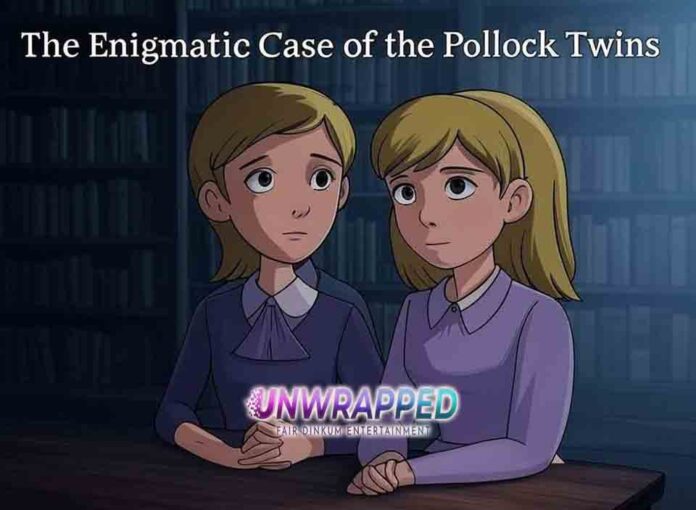The Pollock Twins in the Context of Western Skepticism
What if the memories of your lost loved ones could find their way into another life? Few stories spark debate and wonder like that of the Pollock twins. In 1957, a tragic car accident shattered the Pollock family, claiming the lives of Joanna (11) and Jacqueline (6). One year later, Florence Pollock gave birth to twin girls, Jennifer and Gillian—children who, according to some accounts, bore the birthmarks and even the memories of their deceased sisters.
Reincarnation, the belief that consciousness survives physical death and is reborn in another form or body, is deeply woven into the spiritual tapestries of numerous cultures. While it remains at the fringes of mainstream Western belief, cases like the Pollock twins challenge our understanding of memory, identity, and the very nature of life after death. This article delves into their remarkable story, examining the evidence, the scientific debate, and the broader dialogue between spirituality, neuroscience, and personal belief.
I. The Tragedy of Hexham
In May 1957, the Pollock family from Hexham, England, suffered an unimaginable loss when a car struck and killed Joanna and Jacqueline. Their mother, Florence, and father, John—devout Catholics—were left grappling with profound grief. John’s personal belief in reincarnation offered him a glimmer of hope that this was not the end of the story for his daughters.
Critical Note
The emotional trauma of such a loss inevitably colors how future events are perceived. When studying the Pollock twins’ case, it is essential to recognize the psychological backdrop of a family desperate for solace.
Yet out of this heartbreak arose a new chapter—one that seemed to blur the boundaries between coincidence and the mystical.
II. The Rebirth: Jennifer and Gillian Pollock
On October 4, 1958, just one year after Joanna and Jacqueline’s tragic passing, Florence gave birth to twin girls, Jennifer and Gillian. Twins did not run in the Pollock family, which John regarded as a sign pointing toward reincarnation.
From their earliest days, relatives claimed the twins displayed behaviors and preferences that strongly mirrored those of Joanna and Jacqueline:
- Anecdotal Observations: Gillian was said to exhibit Joanna’s nurturing demeanor and leadership traits. Meanwhile, Jennifer was quieter and had specific birthmarks that seemed to echo Jacqueline’s physical scars.
Critical Note
The family’s intense grief and John’s firm conviction in reincarnation might have created an environment ripe for confirmation bias. Nevertheless, the specificity of some reported parallels drew the attention of researchers, including Dr. Ian Stevenson.
III. Evidence of Reincarnation
A. Physical Markers
A key element of this case centers on Jennifer’s birthmarks. She reportedly had two marks: one on her waist and one on her forehead, resembling a scar Jacqueline once had. Dr. Ian Stevenson, a psychiatrist who investigated reincarnation claims, treated these similarities as more than mere coincidence.
- Scientific Perspective:
- Medical Skepticism: Many experts note that birthmarks are common and not, in themselves, proof of reincarnation.
- Global Patterns: Stevenson cataloged numerous cases worldwide where children had birthmarks corresponding to previous injuries. While intriguing, these remain largely anecdotal from a mainstream scientific viewpoint.
B. Memories and Recognition
As young children, Jennifer and Gillian recognized objects that had belonged to Joanna and Jacqueline. They identified specific toys and recounted details about family trips taken before they were even born. The twins also reportedly described the school their older sisters had attended—yet another striking claim, if true.
Critical Note
- Unconscious Transference: Children can easily pick up details from photographs, stories, or overheard conversations, later presenting them as personal “memories.”
- Suggestibility: Young minds are highly impressionable, which can lead them to absorb family lore so deeply that they confuse it with lived experience.
C. Behavioral Patterns
The twins displayed an unusual fear of cars—a phobia linked by some to the fatal accident that had claimed Joanna and Jacqueline. John and Florence often noted that Jennifer and Gillian became anxious when hearing car engines or seeing vehicles approach.
- Skeptical View:
- Childhood fears can arise from many sources, including parental anxiety or even television. Without more robust data, connecting a child’s phobia to a specific past-life event is speculative.
IV. Dr. Ian Stevenson’s Investigation
Dr. Ian Stevenson was a pioneering figure at the University of Virginia’s Division of Perceptual Studies, dedicating much of his career to documenting over 2,500 childhood cases suggestive of past-life recall. Stevenson’s methodology was painstaking: he conducted multiple interviews, corroborated anecdotal recollections, and reviewed medical or birth records.
- Qualitative vs. Quantitative:
While most mainstream science demands experimental repetition and statistical analysis, Stevenson focused on detailed case studies. He aimed to eliminate normal explanations—like the child’s exposure to family stories—before concluding a case was genuinely unexplained. - Criticisms:
Many scientists argue that anecdotal reports, no matter how detailed, cannot establish proof. Stevenson’s reliance on family testimonies leaves room for subjective bias, distortion of memories, or unintentional coaching.
Still, the Pollock twins, being a Western, Christian family with no cultural tradition of reincarnation, stood out in Stevenson’s body of work, catching the attention of a broader Western audience.
V. Skeptical Perspectives
A. Parental Influence or Hoax
John’s conviction in reincarnation may have led him—consciously or unconsciously—to reinforce certain behaviors in Jennifer and Gillian that echoed Joanna and Jacqueline. Though a few skeptics have alleged the Pollocks staged a hoax, no substantial evidence supports this. Moreover, there appears to be no clear motive for deception.
B. Psychological Explanations
- Cryptomnesia
Occurs when an individual accesses stored information without recognizing its source, mistakenly presenting it as a new memory. - Suggestibility
Children who hear repeated stories of deceased siblings might internalize these narratives, eventually believing (and acting as if) they’ve lived them.
VI. Neuroscientific and Philosophical Implications
The Pollock twins’ story sits at the nexus of brain science, spirituality, and age-old philosophical inquiry.
- Memory and the Brain
Current neuroscience posits that memories are formed, stored, and retrieved through complex neural networks. If consciousness or memory could carry over after death, we still lack a universally accepted mechanism to explain how. - Extended Consciousness Debates
Some thinkers, like philosopher David Chalmers, question whether consciousness might extend beyond the purely physical. Still, most neuroscientists align with the “brain creates consciousness” model. While near-death experience research and studies on psychedelic states suggest consciousness could be more malleable than once believed, none offer a definitive explanation for reincarnation. - Quantum Theories of Consciousness (Fringe Perspective)
A minority of researchers (e.g., Hameroff and Penrose’s “Orch-OR” theory) speculate that quantum processes in the brain might be linked to consciousness. This remains highly controversial and doesn’t directly validate past-life memories—but it opens discussions about how little we truly know about the mind.
Recent Studies: Advances in fMRI and neural imaging have deepened our understanding of memory formation and recall. While these do not specifically support reincarnation, they do highlight how memories might be reconstructed, shared, and even influenced by social contexts—potentially illuminating how children like Jennifer and Gillian could learn and “re-enact” details unconsciously.
VII. Cultural and Global Perspectives on Reincarnation
Reincarnation is central to many Eastern spiritual traditions, notably Hinduism, Buddhism, and certain sects of Jainism and Sikhism. Tibetan Buddhism’s tulku system, for instance, identifies young children as the reincarnations of deceased spiritual masters, supported by recognition of personal objects or uncanny recall of the prior lama’s life.
In Lebanon’s Druze community, past-life memory accounts are sometimes socially accepted and meticulously recorded. Dr. Stevenson’s fieldwork in places like India, Sri Lanka, and the Middle East underscores:
- Comparative Acceptance: In cultures with a normalized belief in reincarnation, family members tend to record children’s peculiar statements more systematically. These records can become persuasive when correlated with specific people or events.
- Western Skepticism: Societies shaped by Christianity or secularism are less inclined to view reincarnation claims as credible. For this reason, the Pollock twins, being from a Catholic family in England, garnered widespread curiosity—they challenged Western assumptions about life and death.
VIII. Personal Reflections
Encountering the Pollock twins’ narrative often sparks a mix of awe and caution:
- Emotional Resonance: For many who have lost loved ones, stories like these evoke hope for a second chance or a sign that consciousness endures.
- Healthy Skepticism: Extraordinary claims warrant scrutiny. Separating genuine anomalies from wishful thinking, suggestion, or misinterpretation demands a careful, critical lens.
Invitation for Guest Posts
We encourage readers to share personal experiences that might parallel these phenomena. Such firsthand accounts can help us broaden the discourse around the mysteries of human consciousness.
IX. Conclusion
Decades on, the Pollock twins’ story remains both a captivating anomaly and a thought-provoking case study. Depending on your viewpoint, it either shines a spotlight on the plausibility of reincarnation or illustrates the power of belief, grief, and the human capacity to weave meaning into coincidence.
- Open Questions: Has the legacy of Joanna and Jacqueline truly continued in Jennifer and Gillian? Or might we be seeing a tapestry of parental grief, coincidence, and childhood imagination?
- Ongoing Debate: Despite countless articles, investigations, and interviews, the Pollock twins’ case is far from settled, continually fueling research into the uncharted realms of mind, spirit, and human psychology.
X. Call to Action
1. Share Your Opinion
- Do you lean toward believing the Pollock twins’ story supports reincarnation? Or do psychological and cultural factors provide a more plausible explanation?
2. Contribute a Story
- Have you or someone you know experienced seemingly inexplicable memories or events suggestive of past lives? Submit your story here for a future blog post discussion.
Recommended Resources
- Division of Perceptual Studies (University of Virginia)
med.virginia.edu/perceptual-studies - PSI Encyclopedia – Pollock Twins Reincarnation Case
psi-encyclopedia.spr.ac.uk - New York Times – Virginia DoPS Reincarnation Article
nytimes.com/2025/01/03/style/virginia-dops-reincarnation.html - Mamamia – Pollock Twins Story
mamamia.com.au/pollock-twins/3
References
- Rana, Darshak. Original X Post (cited in your request).
- Stevenson, Ian. University of Virginia Division of Perceptual Studies.
- PSI Encyclopedia – Pollock Twins Reincarnation Case.
- New York Times – Virginia DoPS Reincarnation Article.
- Mamamia – Pollock Twins Story.
See Also; 8 Hilarious Pubic Hair Grooming Styles and What They (Comedically) Say About You










